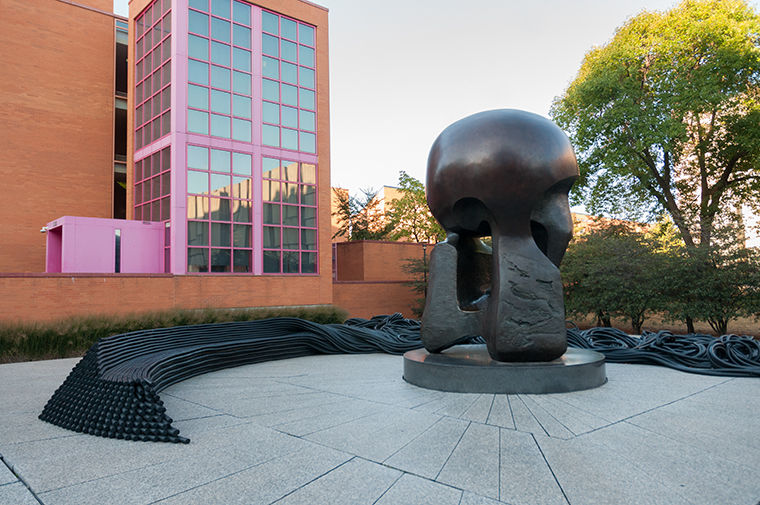Earliest nuclear reactor’s 75th anniversary commemorated
As part of the 75th anniversry of Chicago Pile-1, UChicago Arts collaborated with Ogrydziak Prillinger Architects to create an installation at the location of the first man-made and self-sustaining nuclear chain reaction alongside Henry Moore’s “Nuclear Energy” sculpture.
October 9, 2017
To commemorate the world’s first atomic reactor’s 75th anniversary, the University of Chicago commissioned a temporary sculpture installation at the original campus site and is marking the occasion with a series of public lectures and art events.
Physicist Enrico Fermi and colleagues orchestrated the first controlled, self-sustaining nuclear chain reaction Dec. 2, 1942, in a lab at an abandoned squash court under the since-demolished Stagg Field at 57th and Ellis streets, now graced by Henry Moore’s biomorphic bronze sculpture “Nuclear Energy.”
The sculpture was dedicated 25 years later to mark the birth of a monumental power source with military, industrial and medical applications that began with the creation of a reactor known as Chicago Pile-1.
The “Nuclear Thresholds” installation, created by UChicago Arts and California-based firm Ogrydziak Prillinger Architects, is made from synthetic rubber and wraps around Moore’s sculpture. It begins as a compact bench and gradually unravels to rope-like, tangled strands.
The installation is a spot for contemplation, said Christine Mehring, leader of the lecture series and department chair and professor of Art History at U of C. It is a piece about moving from a state of order and control, captured by the bench aspect, to chaos, which you see in the tangles and unfurled strands, she said. This reflects the nature of the CP-1: controlled conditions of nuclear fission.
The installation sits outside 5265 S. Ellis Ave. and will be viewable until Jan. 7, 2018.Accompanying the project is a lecture series, which leads up to a day of artistic events on the Dec. 2 anniversary.
Nuclear energy’s discovery brought intense ambivalence and amazing scientific possibilities, Mehring said. The arts are in a unique position to reflect on this complex phenomenon, she added.
“I cannot think of anything else in the history of human civilization that brings benefits to civilization and its utter extinction so closely together,” Mehring said. “It’s so vexing and complicated that you almost can’t hold it in your head.”
As a complement to the lecture series, composer and U of C faculty member Augusta Read Thomas composed a vocal exercise known as a “vocalise” for soprano and string quartet titled “Plea for Peace,” which is scheduled to premiere Dec. 1.
According to Thomas, the piece has no lyrics, and the vocalist chants open vowels with a string quartet. Thomas described it as an elegant prayer and reflection. The piece begins as her reflection on CP-1 and then expands into a general call for world peace, she said.
Using both art and science, the university sustains attention toward the 1942 event throughout the fall, said Bill Brown, U of C’s senior adviser to the provost for Arts and co-organizer of the series.
“We are hoping people learn more about the science and the history of the science,” Brown said, “[and] learn more about how deeply and passionately engaged the arts have been with this topic of nuclear energy and nuclear power over the course of decades since the 1940s.”








